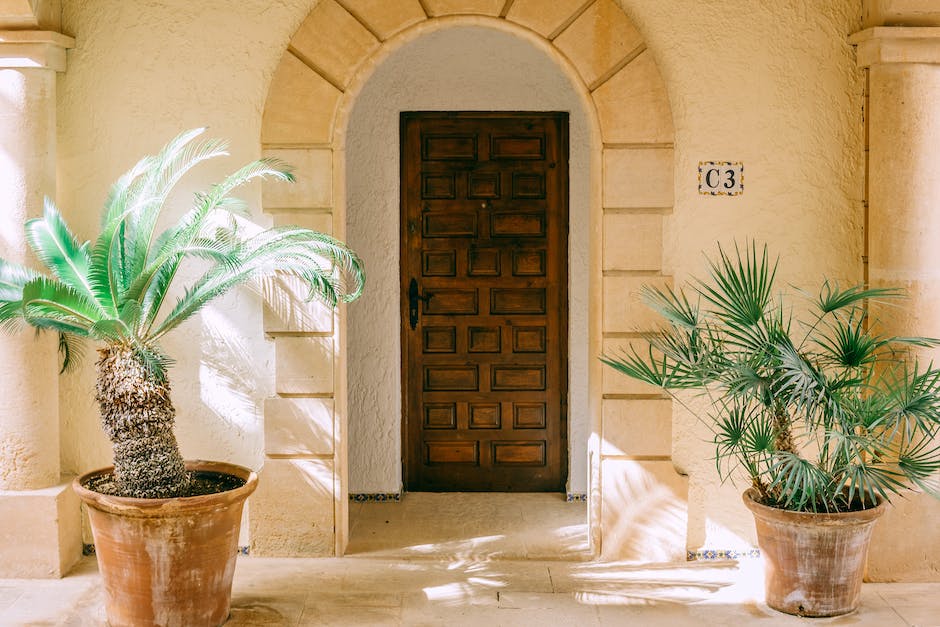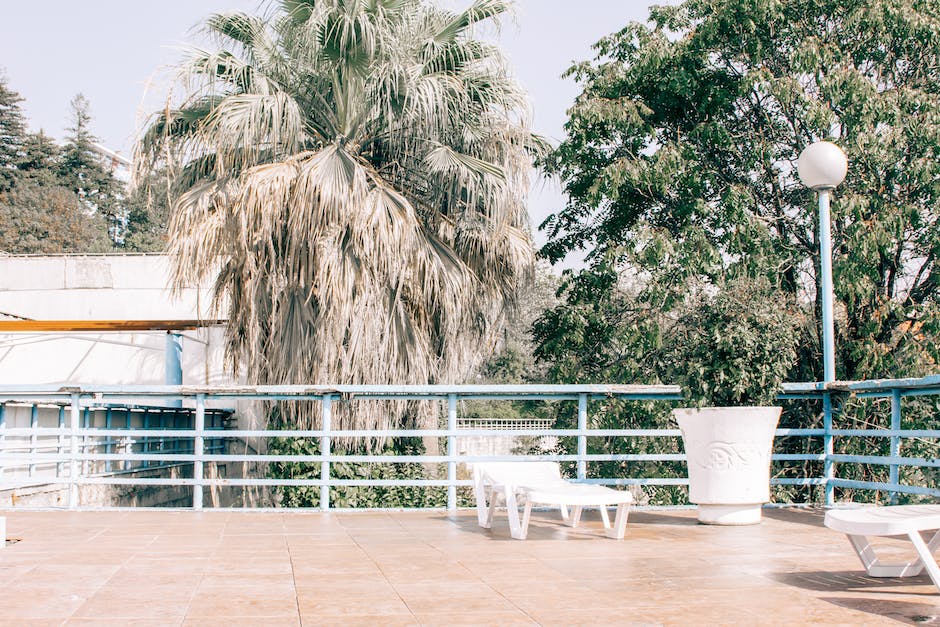Potted palm trees are tropical plants that are typically grown outdoors. In order to overwinter them, you’ll need to take a few precautions. First, you’ll need to bring them inside to a sunny spot. If possible, put them near a south-facing window. Second, you’ll need to water them less frequently. Allow the soil to dry out completely between waterings. Lastly, you’ll need to fertilize them every couple of months with a palm tree fertilizer. With a little care, your potted palm trees will thrive indoors all winter long!
1. Bring your potted palm trees indoors before the first frost.
2. Water your palm tree thoroughly and then allow the excess water to drain.
3. Apply a palm tree fertilizer according to the package directions.
4. Place your palm tree in a bright, sunny location.
5. Reduce watering once the weather turns cold. Allow the soil to dry out between watering.
6. Continue fertilizing your palm tree throughout the winter months.
Can potted palm trees survive winter?
A palm tree can often survive a freeze if it’s well protected. Take care of a palm tree from a sudden freeze by adding an extra layer of protection with a frost-protecting spray product that shields the plant to reduce ice crystal damage.
When expecting a severe ice storm or when temperatures are going to be below 25 degrees for a 24 hour period, your palm should be wrapped. Keep a long sheet of frost cloth and sturdy strap or rope handy for this purpose. These same supplies can be reused year after year. Start by tying the fronds together.
What do you wrap a palm tree with in the winter
This is a great way to secure your leaves while still allowing them to get the sunlight and air circulation they need. Simply wrap a synthetic blanket, burlap or landscape fabric around the trunk and secure it with duct tape. You can continue to wrap it around the lower leaves while gathering them closer into a bunch. Just make sure not to wrap too tightly or you may damage the leaves. Wrap as high as the leaf stiffness allows and enjoy your extended season!
It is important to water container plants deeply and thoroughly to promote healthy root growth. Container plants that are exposed to sun and wind outdoors dry out faster than plants in the ground, so they may need daily summer watering. Containers in protected indoor locations tend to hold moisture better.
How do you winterize patio palms?
Covering the soil above palm trees with mulch will help protect the roots from hard freezes. Wrapping the center spear and the first three to six leaves with water pipe insulation will also help keep the roots from freezing. Be sure to fold the top over to make sure that no water gets inside the insulation.
There are a few things that can be done to protect palms during the winter:
-wrap the trunk in a heavy material (burlap or blankets) to insulate it from the cold
-place a heat lamp near the tree to provide extra warmth
-mulch around the base of the tree to help protect the roots
What is the lowest temperature a palm tree can survive?
Palm trees are not built to withstand extreme cold temperatures and will suffer damage if the temperature drops too low. The lowest recorded temperature that a palm tree can survive is five degrees Fahrenheit. Any lower than that and the plant will most likely die. The reason why they won’t survive below this temperature is that plants are primarily just water. Extremely cold temperatures can result in foliage damage, which can be fatal to the tree. If you live in an area that gets colder than five degrees Fahrenheit, it is best to avoid planting palm trees.
Arecaceae, or the palm family, includes some of the most heat- and cold-tolerant plants in the world. While most palm trees cannot tolerate extended periods of freezing temperatures, there are a few species that are relatively cold-hardy. These palms are often called “cold-hardy palm trees” or “frost-tolerant palms.”
The major factor that determines a palm tree’s tolerance to cold weather is the type of root system it has. Most palm trees have a fibrous root system, which is not very deep and not very strong. This type of root system is not very effective at anchorin trees in strong winds and can be easily damaged by cold weather. On the other hand, some species of palms have a basal root system, which is a deep, robust system of roots that is very effective at anchoring the tree and protecting it from damage.
The two most cold-hardy palm trees are the pygmy date palm (Phoenix roebelenii) and the Chinese windmill palm (Trachycarpusfortunei). These palms can tolerate temperatures as low as 20 degrees Fahrenheit (-6.7 degrees Celsius).
When choosing a cold-hardy palm tree for
Should you water palm trees before a freeze
Ensuring your palm tree is well-watered and fertilized before a freeze is key to helping it weather the cold. Deep watering will help to seal in moisture, and fertilizer will help improve the tree’s vitality and cold tolerance.
1. Move the container to a location sheltered from cold winds and frost, such as a garage, shed or inside your home. If possible, keep the plants in an area with access to sunlight.
2. If you cannot bring the container inside, wrap it in burlap or another breathable material.
3. In extremely cold weather, you may need to provide additional insulation for your plants by placing a light bulb near the container or using a heat mat designed for plants.
4. Be sure to monitor your plants closely during cold weather, and take action quickly if they show signs of distress.
What do you wrap a tree trunk with in the winter?
Burlap is the best choice for tree wrap because it doesn’t exacerbate tree warming and can help the tree maintain a healthy growth cycle.
First, pull the fronds back and tie them. Second, wrap a heat tape (bought at a building supply store), around the trunk beginning at the base. Third, leave the thermostat out at the bottom of the trunk. Fourth, continue wrapping around the entire trunk up to the top.
How long do potted palm trees last
If you are looking for a palm tree to last for a long time, make sure to research the different species to see which one has the longest lifespan. The average lifespan for a palm tree is 7-8 decades, but some can only live for 40 years while others can live for up to 100 years. Choose the species that will best fit your needs so that you can enjoy your palm tree for many years.
Most palm trees are able to thrive in the landscape, but there are also a few species that are better suited for container gardening. In general, if you want to grow a palm in a container, select species that are either slow-growing or low-growing so that they can remain in the same container for 2-4 years.
Should I cut off brown palm leaves?
If the leaves on your palm tree are brown or yellow and wilting, this means they’re dead and you should remove them. Broken fronds should also be removed, as they can damage your tree. Finally, you’ll want to remove fruit stalks of palm flowers since these use up a lot of your palm tree’s energy.
Houseplants are a great way to add some life to your home, but it’s important to follow some basic care guidelines to ensure they stay healthy and thrive. Most palms need temperatures above 45 degrees Fahrenheit to prevent chilling damage, so be sure to protect them from drafts near doors and windows, as well as from air conditioning units. For optimal growth, most palms prefer temperatures of 60 degrees Fahrenheit at night and between 70 and 80 degrees Fahrenheit during the day. With proper care, your houseplants will bring you enjoyment for years to come.
What temperature can potted palms tolerate
Most Majesty palms can withstand a temperature between 35 degrees Fahrenheit to 80 degrees Fahrenheit. However, if the temperature drops below 35, the plant will soon dry out and eventually die.
Once the center, or “heart” of a palm tree has been frozen, the tree is effectively dead. Unlike most other trees, palms are not able to easily handle disease and damage or repair wounds, so once the heart has been frozen, there is no coming back for the tree.
Warp Up
1. Trim your palm tree before winterizing it.
2. Bring your palm tree indoors or wrap it in burlap to protect it from the cold.
3. Water your palm tree less often during winter.
4. Fertilize your palm tree before winter to help it stay healthy.
One way to winterize potted palm trees is to bring them indoors. This is especially important for young palm trees. Place the palm tree in a bright room with a temperature between 60 and 75 degrees Fahrenheit. Water the tree when the soil feels dry. The tree may also need a humidity tray or humidifier to prevent the leaves from drying out. Another way to winterize potted palm trees is to leave them outdoors and care for them as you would during the summer months. Water the tree when the soil feels dry and fertilize it every few months. Protect the tree from cold temperatures by wrapping the pot in burlap or placing it in a protected area.
Mark Hoffman is a dedicated arborist and tree care specialist with over a decade of experience. His love for trees began when he visited Yosemite National Park as a teenager and was awestruck by the giant sequoias. Mark pursued his passion by studying forestry at Michigan Technological University, where he earned a Bachelor of Science degree.
Since then, he has worked tirelessly in the field of arboriculture, helping to preserve and protect trees in his community. His expertise and dedication have made him a respected leader in the industry and a valuable resource for anyone seeking advice on tree care.
